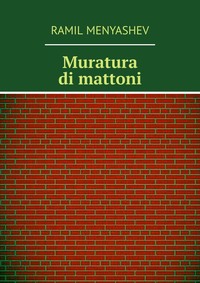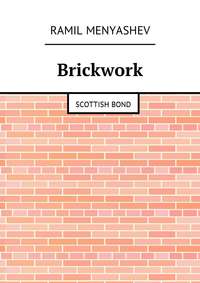
Полная версия
Brickwork bonds

Brickwork bonds
Ramil Menyashev
© Ramil Menyashev, 2020
ISBN 978-5-4490-2039-0
Created with Ridero smart publishing system
Brickwork is a construction consisting of bricks laid in a certain order on the mortar. Rows of bricks, called courses, lie on top of each other, forming brick walls. Bricks laid with a short edge along a wall are called headers; Bricks laid with a long edge along a wall are called stretchers. The thickness of the brickwork is measured by the number of bricks laid in the thickness of the wall, that is, 1 brick, 1.5 brick, 2 brick, 2.5 brick. The thickness of the horizontal joints in the brickwork should be from 10 to 12 mm, the thickness of the vertical joints from 8 to 10 mm. To maintain the horizontality and verticality of the laid bricks use a level, a plumb-line and a builders line.

Fig.1. Brickwork.
Flemish bond
The Flemish bond consists of folded headers and stretchers in each row, with each successive row arranged so that its headers are in the center of the stretchers of the previous row. All vertical seams of the lower row are covered with bricks of the overlying row. Cross-vertical seams in adjacent rows are shifted relative to each other by a quarter of a brick, and longitudinal-vertical ones – by a half-brick. When laying walls with a thickness of 2 bricks, the inner part of the first course consists only of headers, so the pattern inherent in the Flemish bond is obtained only from the outside.

Fig.2. Flemish bond.

Fig.3. The order of laying bricks in the corner of the walls. Wall thickness 1 brick.

Fig.4. The order of laying bricks in the corner of the walls. Wall thickness 1.5 brick.

Fig.5. The order of laying bricks in the corner of the walls. Wall thickness 2 brick.

Fig.6. The order of laying bricks in the vertical constraint of the brick wall. Wall thickness 1 brick.

Fig.7. The order of laying bricks in the vertical constraint of the brick wall. Wall thickness 1.5 brick.

Fig.8. The order of laying bricks in the vertical constraint of the brick wall. Wall thickness 2 brick.

Fig.9. The order of laying bricks in a section of walls between window openings. Wall thickness 1 brick.

Fig.10. The order of laying bricks in a section of walls between window openings. Wall thickness 2 brick.

Fig.11. The order of laying the brick in the adjacent walls. The thickness of the walls is 1 and 1 bricks.

Fig.12. The order of laying the brick in the adjacent walls. The thickness of the walls is 1.5 and 1.5 bricks.

Fig.13. The order of laying the brick in the adjacent walls. The thickness of the walls is 2 and 2 bricks.

Fig.14. The order of laying bricks at the intersection of walls. The thickness of the walls is 1.5 and 1.5 bricks.
Monk bond
Monk bond is similar to the Flemish bond, but the headers are placed here not through one, but after two stretchers. In the first course, the headers are laid through two stretchers; The second course, as well as the first one, consists of a combination of a header and two stretchers, where the header becomes on the seam between two stretchers of the first course, and the seam between the second course stretchers becomes to be on the first course header. All vertical seams of the lower row are covered with bricks of the overlying row. Cross-vertical seams in adjacent rows are shifted relative to each other by a quarter of a brick, and longitudinal-vertical ones – by a half-brick.

Fig.15. Monk bond.

Fig.16. The order of laying bricks in the corner of the walls. Wall thickness 1 brick.

Fig.17. The order of laying bricks in the corner of the walls. Wall thickness 2 brick.

Fig.18. The order of laying bricks in the vertical constraint of the brick wall. Wall thickness 1 brick.

Fig.19. The order of laying bricks in the vertical constraint of the brick wall. Wall thickness 2 brick.

Fig.20. The order of laying bricks in a section of walls between window openings. Wall thickness 1 brick.
Конец ознакомительного фрагмента.
Текст предоставлен ООО «ЛитРес».
Прочитайте эту книгу целиком, купив полную легальную версию на ЛитРес.
Безопасно оплатить книгу можно банковской картой Visa, MasterCard, Maestro, со счета мобильного телефона, с платежного терминала, в салоне МТС или Связной, через PayPal, WebMoney, Яндекс.Деньги, QIWI Кошелек, бонусными картами или другим удобным Вам способом.





